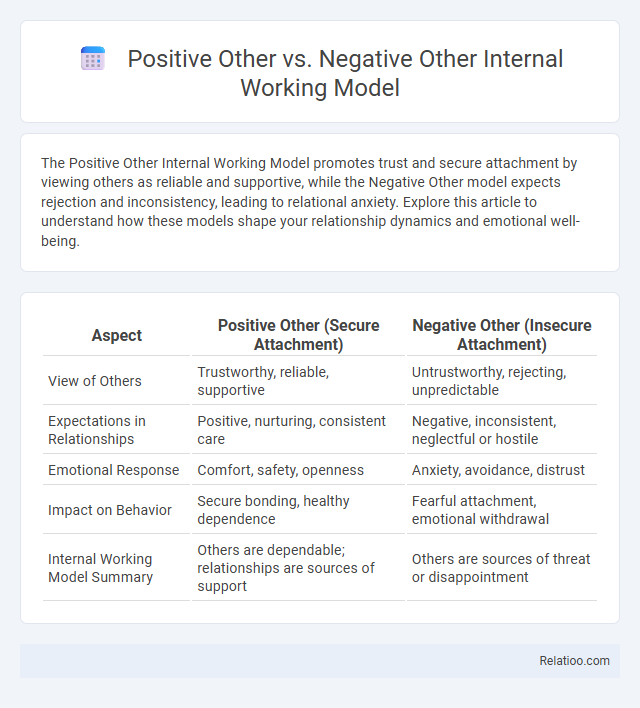The Positive Other Internal Working Model promotes trust and secure attachment by viewing others as reliable and supportive, while the Negative Other model expects rejection and inconsistency, leading to relational anxiety. Explore this article to understand how these models shape your relationship dynamics and emotional well-being.
Table of Comparison
| Aspect | Positive Other (Secure Attachment) | Negative Other (Insecure Attachment) |
|---|---|---|
| View of Others | Trustworthy, reliable, supportive | Untrustworthy, rejecting, unpredictable |
| Expectations in Relationships | Positive, nurturing, consistent care | Negative, inconsistent, neglectful or hostile |
| Emotional Response | Comfort, safety, openness | Anxiety, avoidance, distrust |
| Impact on Behavior | Secure bonding, healthy dependence | Fearful attachment, emotional withdrawal |
| Internal Working Model Summary | Others are dependable; relationships are sources of support | Others are sources of threat or disappointment |
Understanding Internal Working Models: An Overview
Internal Working Models represent cognitive frameworks that shape individuals' expectations and interactions in relationships, influenced by early attachments. The Positive Other model emphasizes trust and reliability in others, fostering secure attachments, while the Negative Other model involves expectations of untrustworthiness and rejection, contributing to anxiety and avoidance. Understanding these models is crucial for addressing relational patterns and promoting emotional well-being.
Defining Positive Other Internal Working Models
Positive Other Internal Working Models represent Your cognitive frameworks where others are viewed as reliable, supportive, and trustworthy, fostering secure attachment and healthy interpersonal relationships. Unlike Negative Other Internal Working Models, which perceive others as unreliable or threatening, Positive Other models boost emotional well-being and social competence. These mental schemas influence how You interpret social cues and respond to relational dynamics, shaping your overall attachment style.
Characteristics of Negative Other Internal Working Models
Negative Other Internal Working Models are characterized by mistrust, expectation of rejection, and perceived hostility from others, leading you to anticipate negative social interactions. These models often result in difficulties forming secure attachments, as individuals view others as unreliable or threatening. The Negative Other Internal Working Model contrasts with the Positive Other Internal Working Model, which is marked by trust, support, and expectation of positive regard from others.
Origins and Development of Internal Working Models
Positive Other Internal Working Models originate from early secure attachments where caregivers provide consistent support, fostering trust and healthy relational expectations. Negative Other Internal Working Models develop when caregivers are unpredictable or neglectful, leading to mistrust and avoidance in relationships. Your internal working model, shaped by these early interactions, influences how you interpret social cues and form bonds throughout life.
Impacts on Attachment Styles
Positive Other internal working models foster secure attachment by promoting trust and expectations of reliability in relationships, leading to healthy interpersonal connections. Negative Other models contribute to anxious or avoidant attachment styles by generating fears of rejection or unavailability, resulting in emotional distance or hypervigilance. The overall internal working model integrates both self and other perceptions, significantly shaping attachment behaviors and emotional regulation patterns in adult relationships.
How Positive Other Models Foster Healthy Relationships
Positive Other Internal Working Models shape Your perception of others as trustworthy, supportive, and reliable, leading to healthier interpersonal connections and effective communication. These models foster secure attachment by promoting empathy, emotional regulation, and mutual respect, which enhances relationship satisfaction and stability. In contrast, Negative Other Models often result in mistrust, anxiety, and avoidance, undermining the development of strong, positive bonds.
Consequences of Negative Other Models in Adult Life
Negative Other Internal Working Models in adult life often result in persistent mistrust and difficulty forming intimate relationships, leading to social withdrawal and emotional distress. These models can cause individuals to interpret others' actions as hostile or rejecting, reinforcing cycles of anxiety and avoidance. Consequently, personal and professional relationships may suffer, limiting social support networks and overall psychological well-being.
Strategies for Shifting from Negative to Positive Models
Shifting from a Negative Other Internal Working Model to a Positive Other Model involves actively challenging and reframing negative beliefs about others through mindfulness, cognitive restructuring, and building trust in relationships. Your strategies should include increasing exposure to supportive social interactions, practicing empathy, and seeking therapeutic techniques like attachment-based therapy to revise maladaptive patterns. Consistent use of positive reinforcement and secure emotional experiences helps solidify a healthier internal working model, promoting improved interpersonal connections.
Role of Therapy in Rewiring Internal Working Models
Therapy plays a crucial role in rewiring internal working models by helping individuals reconstruct their perceptions of self and others, shifting from a Negative Other model--characterized by mistrust and fear--to a Positive Other model marked by security and openness. Techniques such as cognitive-behavioral therapy, attachment-based therapy, and mindfulness practices facilitate neural plasticity, promoting healthier relational schemas and emotional regulation. Consistent therapeutic intervention enables the restructuring of maladaptive internal working models, supporting sustained relational and psychological well-being.
Building Resilience Through Positive Relational Experiences
Positive Other internal working models foster resilience by anchoring beliefs in trust, support, and secure attachments, enabling individuals to navigate stress with confidence. Negative Other internal working models often lead to mistrust and vulnerability, hindering adaptive coping strategies and increasing susceptibility to psychological distress. Building resilience involves cultivating positive relational experiences that reshape internal working models toward security, promoting emotional regulation and healthier interpersonal interactions.

Infographic: Positive Other vs Negative Other Internal Working Model
 relatioo.com
relatioo.com